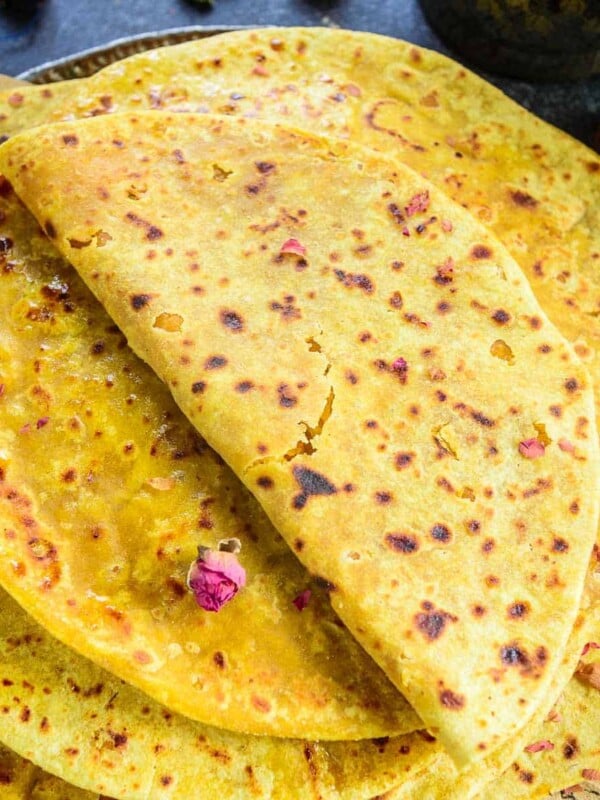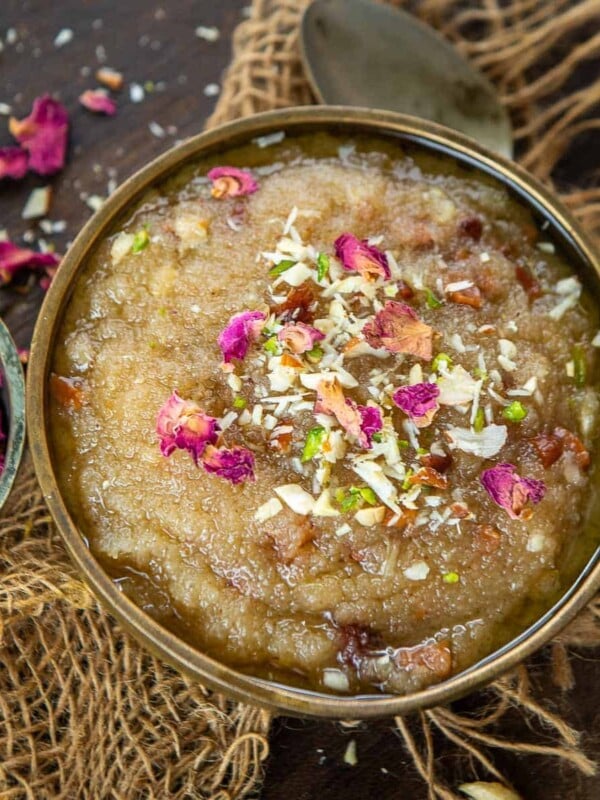on Oct 28, 2024 If you are looking to make some more homemade Indian desserts, then here are some of my other favorites – Bread Halwa, Malpua, Kesar Elaichi Shrikhand, Makhana Kheer, and Basundi.
About Rabdi
Rabdi (Rabri) is a traditional North Indian sweet, which is evaporated sweet, thickened milk. It is popularly prepared during festivals and weddings. It is also called laccha rabdi or lacchedar rabri as the layers of milk fat (malai) get collected on top of the milk as it cooks making lacchas (strings) which are added back to the pan, making the reduced milk chunky (lacchedar). Rabdi is a creamy, thick-textured dessert that comes together in an hour using simple pantry ingredients – milk, sugar, saffron, cornstarch and rose water. To make rabdi, milk is added to a large shallow pan and it is reduced for hours over low flame. It gets caramelized and has a lovely pinkish hue and a delicate taste from this process. There are many instant variations of rabdi recipe that you can make. You can add condensed milk, ricotta cheese, milk powder, etc., to the recipe, but trust me; nothing compares to the one made by slow-cooking the milk. In this post, I am sharing the authentic version I learned from my mom, who is an excellent cook. I have seen people relish her homemade rabri and always ask her for the recipe. My recipe serves 4, but you can easily double or triple it. Consider that the cooking time will increase if the recipe is scaled.
Variations
You can make variations of rabdi like sitafal rabdi, anjeer rabdi, angoor rabdi, etc., by adding fruits purees to the finished rabdi. For the best texture, use full-fat milk (whole milk) that will give the creamiest consistency to rabri. Do not use skim or low-fat milk to make this dessert. Full fat buffalo milk is the best to make rabdi as its fat content is higher than cow’s milk. But if it’s unavailable, you can use cow’s milk too. You can adjust the amount of sugar as per your taste. i like mildly sweet desserts and hence added sugar as per my taste but if you like sweeter rabdi, then feel free to add more sugar. Opt for high-quality saffron; it gives a beautiful yellow tinge and subtle flavor to the rabdi. Do not miss my secret ingredient – rose water, which will instantly change the taste game of your delicious rabdi. Traditionally cornstarch is not added while making lachcha rabdi. However, to reduce the cooking time, I learned this technique from a local sweetshop to add a little cornflour slurry to the milk once it is reduced to almost half. Trust me, you will not figure out any difference in taste, and the cooking time will be reduced to almost half. Garnish the ready rabdi with dry fruits and nuts such as almonds, cashews, pistachios, etc. They give a nice crunch to this otherwise soft sweet and also make it look nice. To make the rabdi even more indulgent, you can garnish it with some silver or gold foil. You can also add a teaspoon of ground cardamom powder to flavor this easy rabri recipe. Note – Try to use a wide pan for fastening the cooking process. Add 1 pinch of saffron strands to the pan and give it a mix. Using a spatula, move the layer of malai to the side of the pan or mix it back with the milk. Scrape the sides of the pan at regular intervals and keep adding the milk solids back to the pan. Keep scraping the bottom of the pan at regular intervals to avoid scorching. Cook similarly (that is undisturbed for 1-2 minutes and mix the fat layer back) until the milk is reduced to more than half (30-35 minutes). Garnish with almond and pistachio slivers and dried rose petals. You can soak some saffron strands in water for 3-4 hours and pour the saffron soaked water over the rabdi to make it look even more indulgent. Silver or gold foil can also be used as a garnishing. Either serve hot or chill in the refrigerator for a few hours before serving. The key tip for making rabri is to find the right balance between leaving the milk alone so that the malai layer forms and stirring enough to not stick and burn on the bottom. Do not leave the pan unattended. The milk burns quickly, and your entire effort will be wasted. Rabdi slightly thickens after it cools down. So keep that in mind. Chill rabdi before eating; it tastes even more delicious this way. In case it becomes too thick after refrigerating, add a little chilled milk and adjust the consistency. I love mango rabri (aam ki rabdi) made using fresh mango puree when mangoes are in season.
Serving Suggestions
You can eat rabdi alone for dessert or pair it with warm Gulab Jamuns, Shahi Tukda, Imarti, Jalebi, or Malpua. Make it for the festive season, special occasions, or for the guests at home.
Storage Suggestions
Rabri will last in the fridge for 3-4 days when stored in an air-tight container. Bring the cooked rabdi to room temperature and then transfer it to a container. Make sure to use a clean and dry spoon every time you take out rabdi from the container, and do close the lid tightly after every use. Whenever I make rabdi, I make a big batch. I use some of it instantly and freeze the remaining in small containers. Rabdi freezes very well for up to 2 months. Just transfer it to a freezer-safe container and freeze it for later use. Whenever you are ready to use, either keep it on the counter for 2-3 hours or in the refrigerator overnight.
Maharashtrian Puran Poli Sweet
Moong Dal Halwa
Sooji Halwa
Phirni (Firni)













